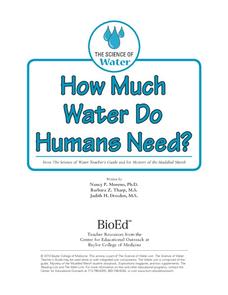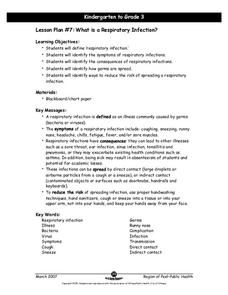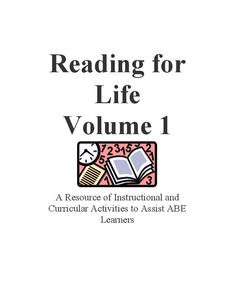Baylor College
How Much Water Do Humans Need?
Physical or life science learners measure the amounts of water eliminated by intestines and the urinary system, and the amounts lost via respiration and perspiration. In doing so, they discover that the body's water must be replenished...
Peel-Public Health
What Is Respiratory Infection?
Give your youngsters a comprehensive introduction to the importance of washing hands and preventing the spread of germs in three activities, which include identifying what germs are, discovering where germs live, and practicing a...
Curated OER
Today I Feel Silly Activity Plan
A big part of learning how to be emotionally healthy is learning how to identify and express your emotions. The book Today I Feel Silly is the inspiration for a wonderful activity plan that is intended to teach young children how to be...
Baylor College
Heart and Lungs
With a partner, youngsters measure their pulse and breathing rates, both at rest and after running in place for a minute. While this activity is not novel, the lesson plan includes a large-scale classroom graphing activity and other...
Baylor College
What Dissolves in Water?
One of water's claims to fame is as the universal solvent. Young physical scientists experiment to discover which materials dissolve in this special compound. You could never be more prepared for teaching this lesson than by using this...
Baylor College
There's Something in the Air
Clever! In order to compare indoor and outdoor dispersal rates for the movement of gases and particles through air, collaborators will participate in a classroom experiment. Set up a circular grid and set students on lines that are...
Baylor College
How Do We Use Water?
Send youngsters home to survey how they use water in their homes. Then bring them together to discuss which uses are essential for our health and which are not. A helpful video offers teaching tips for this lesson, and a presentation...
Baylor College
Gases Matter
As a demonstration or as a hands-on activity, your class watches as the combination of vinegar and baking soda produce carbon dioxide gas. The intent of the lesson is to help youngsters understand that gases occupy space. It is included...
Curated OER
Good and Bad Touches
Students evaluate whether certain physical actions constitute a "good touch" or a "bad touch". In this sensitive health lesson, students are read a book about types of touches, and then compare and contrast between good and bad types....
Curated OER
Reading for Life
Imagine a packet packed with reading resources designed for every grade and reading level. Imagine worksheets, graphic organizers, flash cards, activities, and exercises. This is just such a packet and is well worth...
Curated OER
I can do What I Want
Learners recognize gender bias and stereotyping. For this self-esteem lesson, students listen to Amazing Grace by Mary Hoffman and discuss how girls can be successful and provide positive role models for others.
National Institute for Literacy
Making Sense of Decoding and Spelling
Go over digraphs, vowel sounds, and affixes with a series of decoding and spelling lessons. Each lesson guides learners through a different reading and phonics skill, building on the lesson before, and challenging them with each step.
Curated OER
Helping People Who Are Hungry
Students discuss the concept of hunger. In this hunger lesson, students discuss the book, The Story of Stone Soup. Student then brainstorm a possible service project ideas and create plans to carry out their service project.
Curated OER
What's For Breakfast, Lunch, and Dinner?
Students identify breakfast, lunch, and dinner foods. In this dietary awareness lesson, students draw pictures of their favorite foods and arrange the complete pictures on a bulletin board. Students discuss the details of their pictures...
Baylor College
Needs of Plants
What better way to learn about plant life than by creating a class garden? Young botanists start with a brief discussion about radishes before planting seeds and watching them grow. To determine the importance of water,...
Curated OER
Can You Name Parts of the Body?
Students share what they know about the human heart. In this early anatomy lesson, students discuss the location, shape, and importance of the human heart.
Curated OER
Get Acquainted with the Great Outdoors
National Parks and Recreation Month offers opportunities to improve health and education.
US Environmental Protection Agency
Aquifer in a Cup
Young scientists create their very own aquifers in this science lesson on ground water. After learning about how some people get their drinking water from underground wells, young learners use sand, modeling clay, and aquarium rocks to...
Curated OER
Feelings and Emotions
Students discuss and write about different feelings they or someone else may have. In this feelings lesson plan, students discuss different ways they express their feelings. Then they get a picture with someone who is demonstrating a...
Baylor College
What's Is Soil Made Of?
It's time to roll up those sleeves and get a little dirty in the second lesson of this series on the science of food. Investigate where plants and animals get the minerals they need to live in this two-part exploration of soil. First,...
Baylor College
Using Food Labels
Help your class make sense of nutrition labels with the ninth lesson of this series. After explaining the different information provided on packaged food labels, perform an activity that demonstrates the amount of sugar in a single can...
Baylor College
Fungus Among Us
In order to learn that mold spores can be found in the air, observers grow bread mold and make observations for a few days. Afterward, they participate in a class discussion to arrive at the knowledge that bread spores are present in the...
Curated OER
Feelings
Students describe how they feel in different situations. In this feelings lesson plan, students respond to questions asked by the teacher while reading the book The Way I Feel. They also use mirrors to show look at their own faces while...
Baylor College
Do Plants Need Light?
Turn your classroom into a greenhouse with a lesson on plant growth. First, investigate the different parts of seeds, identifying the seed coat, cotyledon, and embryo. Then plant the seeds and watch them grow! Measure the new plants...























